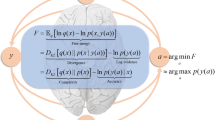Abstract
It has been proposed that intentional actions are supplied by a generative system of the sort described by Chomsky for language. In this paper I aim to provide a closer analysis of this claim for the sake of conceptual clarification. To this end, I will first clarify what is involved in the thesis of a structural analogy between language and action, and then I will consider what kind of evidence there seems to be in favour of the thesis of a neurobiological identity. On this basis, I will subsequently focus on two definitional issues. The first is whether, as the claim of a generative system for intentional action suggests, humans may perform an infinite number of possible actions. The second is whether, as the claim of a generative system for intentional action suggests, what is at issue is conscious planning of action and therefore controlled processing.
Similar content being viewed by others
Notes
I am not considering here the way in which, even for the same utterance, communicative intention may change as a function of context. However, at a first approximation that issue may be set aside. As a matter of fact, in the quotation above Sperber and Wilson (2002) seem to suggest that communicative intentions are just as complex as it would be predicted by the syntactic structure of the corresponding utterances.
References
Baars B, Gage N (2010) Cognition, brain and consciousness. Academic Press, Amsterdam
Baldwin D, Baird J (2001) Discerning intentions in dynamic human action. Trends Cogn Sci 5:171–178
Bauer P (1995) Recalling past events: from infancy to early childhood. Ann Child Dev 11:25–71
Bookheimer S (2002) Functional MRI of language: new approaches to understanding the cortical organization of semantic processing. Annu Rev Neurosci 25:151–188
Botvinick M (2008) Hierarchical models of behavior and prefrontal function. Trends Cogn Sci 12:201–208
Clerget E, Winderickx A, Fadiga L et al (2009) Role of Broca’s area in encoding sequential human actions: a virtual lesion study. NeuroReport 20:1496–1499
Fadiga L, Craighero L, D’Ausilio A (2009) Broca’s area in language, action, and music. Ann NY Acad Sci 1169:448–458
Fazio P, Cantagallo A, Craighero L et al (2009) Encoding of human action in Broca’s area. Brain 132:1980–1988
Fuster J (1990) Prefrontal cortex and the bridging of temporal gaps in the perception-action cycle. Ann NY Acad Sci 608:318–329
Fuster J (2001) The prefrontal cortex-An update: time is of the essence. Neuron 2:319–333
Fuster J (2003) Cortex and mind. Unifying cognition, Oxford University Press, Oxford
Fuster J (2004) Upper processing stages of the perception-action cycle. Trends Cogn Sci 8:143–145
Gough P, Nobre A, Devlin J (2005) Dissociating linguistic processes in the left inferior frontal cortex with transcranial magnetic stimulation. J Neurosci 25:8010–8016
Grafton S, Hamilton A (2007) Evidence for a distributed hierarchy of action representation in the brain. Hum Movement Sci 26:590–616
Hagoort P (2005) On Broca, brain, and binding: a new framework. Trends Cogn Sci 9:416–423
Higuchi S, Chaminade T, Imamizu H et al (2007) Shared neural correlates for language and tool use in Broca’s area. NeuroReport 20:1376–1381
Jackendoff R (2002) Foundations of language. Brain, meaning, grammar, Evolution. Oxford University Press, Oxford
Jackendoff R (2007a) A parallel architecture perspective on language processing. Brain Res 1146:2–22
Jackendoff R (2007b) Language, consciousness, culture: essays on mental structure (Jean Nicod Lectures). MIT Press, Cambridge, MA
Jackendoff R, Pinker S (2005) The nature of the language faculty and its implications for evolution of language (Reply to Fitch, Hauser, & Chomsky). Cognition 97:211–225
Jordan J (2003) Consciousness on the edge: The intentional nature of experience. In: Science and Consciousness Review. http://www.scicon.org/news/articles/20040101.html. Cited 19 Feb 2013
Koechlin E, Jubault T (2006) Broca’s area and the hierarchical organization of human behavior. Neuron 50:963–974
Kuperberg G (2007) Neural mechanisms of language comprehension: challenges to syntax. Brain Res 1146:23–49
Levelt W (1989) Speaking: from intention to articulation. MIT Press, Cambridge, MA
Mazzone M (2014) Automatic and controlled processes in pragmatics. In: Capone A, Lo Piparo F, Carapezza M (ed) Perspectives on linguistic pragmatics. Springer (forthcoming)
Mazzone M, Campisi E (2013) Distributed intentionality: a model of intentional behavior in humans. Philos Psychol 26:267–290
Pastra K, Aloimonos Y (2012) The minimalist grammar of action. Philos T R Soc B 367:103–117
Roby-Brami A, Hermsdorfer J, Roy A et al (2012) A neuropsychological perspective on the link between language and praxis in modern humans. Philos T R Soc B 367:144–160
Rougier N, Noelle D, Braver T et al (2005) Prefrontal cortex and flexible cognitive control: rules without symbols. Proc Natl Acad Sci USA 102:7338–7343
Sitnikova T, Holcomb P, Kiyonaga K et al (2008) Two neurocognitive mechanisms of semantic integration during the comprehension of visual real-world events. J Cogn Neurosci 20:1–21
Sperber D, Wilson D (2002) Pragmatics, modularity and mind-reading. Mind Lang 17:3–23
Tettamanti M, Weniger D (2006) Broca’s area: a supramodal hierarchical processor? Cortex 42:491–494
Whiten A, Flynn E, Brown K et al (2006) Imitation of hierarchical action structure by young children. Dev Sci 9:574–582
Author information
Authors and Affiliations
Corresponding author
Rights and permissions
About this article
Cite this article
Mazzone, M. A Generative System for Intentional Action?. Topoi 33, 77–85 (2014). https://doi.org/10.1007/s11245-013-9186-7
Published:
Issue Date:
DOI: https://doi.org/10.1007/s11245-013-9186-7



